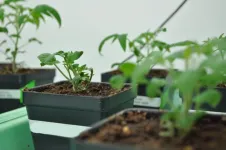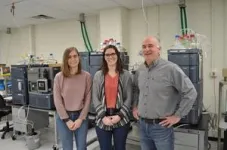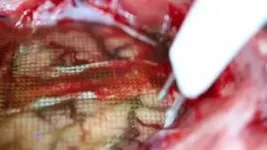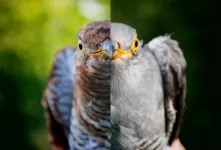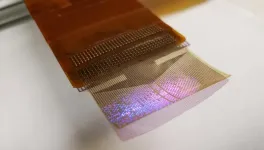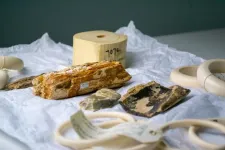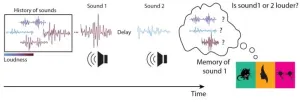(Press-News.org) In a new paper appearing in Science Advances, Michigan State University researchers have unraveled a surprising genetic mystery centered on sugars found in what gardeners know as “tomato tar.”
Anyone who has pruned tomato plants barehanded has likely found their fingers darkened with a sticky, gold-black substance that won’t quite wash off.
This tomato tar is sticky for good reason. It’s made of sugars — acylsugars, to be precise — and acts as a sort of natural flypaper for would-be pests.
“Plants have evolved to make so many amazing poisons and other biologically active compounds,” said Michigan State researcher Robert Last, leader of the new study.
The Last lab specializes in acylsugars and the tiny, hair-like structures where they’re produced and stored, known as trichomes.
Once thought to be exclusively found in trichomes, other researchers recently reported finding acylsugars in tomato roots as well. This was a surprise for the plant science community.
In their study, the team at MSU wanted to learn how these root acylsugars functioned and just where they came from.
They found that not only do tomato plants synthesize chemically unique acylsugars in their roots and trichomes, but these acylsugars are produced through two parallel metabolic pathways.
This is the equivalent of assembly lines in an auto factory making two different models of the same car, but never interacting.
These discoveries are helping scientists to better understand the resilience and evolutionary story of Solanaceae, or nightshades, a sprawling family of plants that includes tomatoes, eggplants, potatoes, peppers, tobacco and petunias. They could also help inform researchers looking to develop molecules made by plants into compounds to help humanity.
“From pharmaceuticals, to pesticides, to sunscreens, many small molecules that humans have adapted for different uses come from the arms race between plants, microbes and insects,” Last said.
Roots and shoots
Beyond key chemicals essential for growth, plants also produce a treasure trove of compounds that play a crucial role in environmental interactions. These can attract useful pollinators and are the first line of defense against harmful organisms.
“What’s so remarkable about these specialized metabolites is that they’re typically synthesized in highly precise cells and tissues,” said Rachel Kerwin, a postdoctoral researcher at MSU and first author of the latest paper.
“Take for instance acylsugars. You won’t find them produced in the leaves or stems of a tomato plant. These physically sticky defense metabolites are made right in the tip of the trichomes.”
When it was reported that acylsugars could be found in tomato roots as well, Kerwin took it as a call for old-fashioned genetic detective work.
“The presence of these acylsugars in roots was fascinating and led to so many questions. How did this happen, how are they being made and are they different from the trichome acylsugars we’ve been studying?”
To begin tackling the evolutionary enigma, lab members collaborated with specialists at MSU’s Mass Spectrometry and Metabolomics Core, as well as staff at the Max T. Rogers Nuclear Magnetic Resonance facility.
In comparing metabolites from tomato seedlings’ roots and shoots, a variety of differences appeared.
The basic chemical make-up of the aboveground and belowground acylsugars were noticeably different, so much so that they could be defined as different classes of acylsugars entirely.
Breaking the car
Last, a University Distinguished Professor in MSU’s College of Natural Science's Department of Biochemistry and Molecular Biology and Department of Plant Biology, offers a useful analogy to explain how a geneticist approaches biology.
“Imagine trying to figure out how a car works by breaking one component at a time,” he said. “If you flatten a car’s tires and notice the engine still runs, you’ve discovered a critical fact even if you don’t know what the tires exactly do.”
Switch out car parts for genes, and you get a clearer picture of the work accomplished by the Last lab to further crack the code on root acylsugars.
Looking at public genetic sequence data, Kerwin noticed that many of the genes expressed in tomato trichome acylsugar production had close relatives in roots. After identifying an enzyme believed to be the first step in root acylsugar biosynthesis, the researchers began “breaking the car.”
When they knocked out the root acylsugar candidate gene, root acylsugar production vanished, leaving trichome acylsugar production untouched.
Meanwhile, when the well-studied trichome acylsugar gene was knocked out, root acylsugar production carried on as usual.
These findings offered striking proof of a suspected metabolic mirroring.
“Alongside the aboveground acylsugar pathway we’ve been studying for years, here we find this second parallel universe that exists underground,” Last said.
“This confirmed we have two pathways co-existing in the same plant,” Kerwin added.
To drive home this breakthrough, Jaynee Hart, a postdoctoral researcher and second author on the latest paper, looked closer at the functions of trichome and root enzymes.
Just as trichome enzymes and the acylsugars they produce are a well-studied chemical match, she found a promising link between root enzymes and the root acylsugars as well.
“Studying isolated enzymes is a powerful tool for ascertaining their activity and drawing conclusions about their functional role inside the plant cell,” Hart explained.
These findings were further proof of the parallel metabolic pathways that exist in a single tomato plant.
“Plants and cars are so different, yet similar in that when you open the proverbial hood you become aware of the multitude of parts and connections that make them function. This work gives us new knowledge about one of those parts in tomato plants and prompts further research into its evolution and function and whether we can make use of it in other ways,” said Pankaj Jaiswal, a program director at the U.S. National Science Foundation, which funded the work.
“The more we learn about living things — from tomatoes and other crops, to animals and microbes — the broader the opportunities to employ that learning to benefit society,” he added.
Clusters within clusters
The paper also reports a fascinating and unexpected twist concerned with biosynthetic gene clusters, or BGCs.
BGCs are collections of genes that are physically grouped on the chromosome and contribute to a particular metabolic pathway.
Previously, the Last lab identified a BGC containing genes linked to trichome acylsugars in tomato plants. Kerwin, Hart, and their collaborators have now discovered the root-expressed acylsugar enzyme resides in the same cluster.
“Usually in BGCs, the genes are co-expressed in the same tissues and under similar conditions,” said Kerwin.
“But here, we have two separate yet interlinked groups of genes. Some expressed in trichomes, and some expressed in roots.”
This revelation led Kerwin to dive into the evolutionary trajectory of Solanaceae species, with hopes to identify when and how these two unique acylsugar pathways developed.
Specifically, the researchers drew attention to a moment some 19 million years ago when the enzyme responsible for trichome acylsugars was duplicated. This enzyme would one day be responsible for the newly discovered root-expressed acylsugar pathway.
The exact mechanism that “switched on” this enzyme in roots remains unknown, paving the way for the Last lab to continue to unpack the evolutionary and metabolic secrets of the nightshade family.
“Working with Solanaceae provides so many scientific resources, as well as a strong community of researchers,” said Kerwin.
“Through their importance as crops and in horticulture, these are plants humans have cared about for thousands of years.”
For Last, these breakthroughs are also a reminder of the importance of natural pesticides, which defense metabolites such as acylsugars ultimately represent.
“If we find that these root acylsugars are effective at repelling harmful organisms, could they be bred into other nightshades, thereby helping plants grow without the need for harmful synthetic fungicides and pesticides?” Last asked.
“These are questions at the core of humanity’s pursuit of purer water, safer food and a reduced reliance on harmful synthetic chemicals.”
END
MSU researchers uncover 'parallel universe' in tomato genetics
The findings shed new light on the ways defense metabolites like acylsugars could lead to improved natural pesticides
2024-04-24
ELSE PRESS RELEASES FROM THIS DATE:
Grey cuckoo, red cuckoo: unveiling the genomic secrets of color polymorphism in female cuckoo birds
2024-04-24
NEW YORK, April 24, 2024 — Sexual dimorphism—the visible difference between females and males—can be seen in diverse animals, including humans. One intriguing aspect of this phenomenon is sex-limited polymorphism, where one sex displays greater variations in a particular trait than the other. In a recent study published in Science Advances, a team of researchers delve into the genetic underpinnings behind the color polymorphism observed in adult females of the brood parasitic Cuculus, more widely known as cuckoo birds, shedding light on the evolution and functional significance of this phenomenon.
Several species of cuckoos, a genus of birds ...
CHOP researchers discover underlying biology behind Fontan-associated liver disease
2024-04-24
Philadelphia, April 24, 2024 – As patients with congenital heart diseases live longer, researchers are attempting to understand some of the other complications they may face as they age. In a new study, a team from Children’s Hospital of Philadelphia (CHOP) used state-of-the-art technologies to understand the underlying biology of Fontan-associated liver disease (FALD).
The findings, published today in Science Translational Medicine, reveal unprecedented insights into how the disease develops and potential therapeutic targets for future treatment options.
The Fontan operation is ...
A flexible microdisplay can monitor brain activity in real-time during brain surgery
2024-04-24
A thin film that combines an electrode grid and LEDs can both track and produce a visual representation of the brain’s activity in real-time during surgery–a huge improvement over the current state of the art. The device is designed to provide neurosurgeons visual information about a patient’s brain to monitor brain states during surgical interventions to remove brain lesions including tumors and epileptic tissue.
Each LED in the device mirrors the activity of a few thousand neurons. In a series of proof-of-concept experiments in rodents and large non-primate mammals, researchers showed that ...
Diversity and productivity go branch-in-branch
2024-04-24
Kyoto, Japan -- Climate change can be characterized as the Grim Reaper or some other harbinger of dire times for humanity and natural environment, including forests. Previous studies reporting a decline in forest productivity due to climate warming and long-term drought may suggest that trees' survival hangs in the balance.
Now, a study by an international group, including Kyoto University, found that forests with higher trait diversity not only adapt better to climate change but may also thrive.
The study, conducted by researchers from Lakehead ...
Color variants in cuckoos: the advantages of rareness
2024-04-24
Every cuckoo is an adopted child – raised by foster parents, into whose nest the cuckoo mother smuggled her egg. The cuckoo mother is aided in this subterfuge by her resemblance to a bird of prey. There are two variants of female cuckoos: a gray morph that looks like a sparrowhawk, and a rufous morph. Male cuckoos are always gray.
“With this mimicry, the bird imitates dangerous predators of the host birds, so that they keep their distance instead of attacking,” says Professor Jochen Wolf from LMU Munich. Together with researchers at CIBIO (Centro de Investigação ...
Laser technology offers breakthrough in detecting illegal ivory
2024-04-24
A new way of quickly distinguishing between illegal elephant ivory and legal mammoth tusk ivory could prove critical to fighting the illegal ivory trade. A laser-based approach developed by scientists at the Universities of Bristol and Lancaster, could be used by customs worldwide to aid in the enforcement of illegal ivory from being traded under the guise of legal ivory. Results from the study are published in PLOS ONE today [24 April].
Despite the Convention on the International Trade in Endangered Species (CITES) ban on ivory, poaching associated with its illegal trade has ...
Why can’t robots outrun animals?
2024-04-24
Robotics engineers have worked for decades and invested many millions of research dollars in attempts to create a robot that can walk or run as well as an animal. And yet, it remains the case that many animals are capable of feats that would be impossible for robots that exist today.
“A wildebeest can migrate for thousands of kilometres over rough terrain, a mountain goat can climb up a literal cliff, finding footholds that don't even seem to be there, and cockroaches can lose a leg and not slow down,” ...
After spinal cord injury, neurons wreak havoc on metabolism
2024-04-24
COLUMBUS, Ohio – Conditions such as diabetes, heart attack and vascular diseases commonly diagnosed in people with spinal cord injuries can be traced to abnormal post-injury neuronal activity that causes abdominal fat tissue compounds to leak and pool in the liver and other organs, a new animal study has found.
After discovering the connection between dysregulated neuron function and the breakdown of triglycerides in fat tissue in mice, researchers found that a short course of the drug gabapentin, commonly prescribed for nerve pain, prevented ...
Network model unifies recency and central tendency biases
2024-04-24
Neuroscientists have revealed that recency bias in working memory naturally leads to central tendency bias, the phenomenon where people’s (and animals’) judgements are biased towards the average of previous observations. Their findings may hint at why the phenomenon is so ubiquitous.
Researchers in the Akrami Lab at the Sainsbury Wellcome Centre at UCL and the Clopath Lab at Imperial College London developed a network model with a working memory module and another accounting for sensory histories. The study, published in eLife, describes how the model shows neural circuits ...
Ludwig Lausanne scientists identify and show how to target a key tumor defense against immune attack
2024-04-24
April 24, 2024, NEW YORK – A Ludwig Cancer Research study has discovered how a lipid molecule found at high levels within tumors undermines the anti-cancer immune response and compromises a recently approved immunotherapy known as adoptive cell therapy (ACT) using tumor infiltrating lymphocytes, or TIL-ACT. In this individualized cell therapy, TILs—CD8+ T cells that kill cancer cells—are expanded in culture from a patient’s tumor samples and reinfused into the patient as a treatment.
Researchers led by Ludwig Lausanne’s Matteo ...
LAST 30 PRESS RELEASES:
Post-stroke injection protects the brain in preclinical study
Cardiovascular risk score predicts multiple eye diseases
Health: estimated one in ten British adults used or interested in GLP-1 medications for weight loss
Exercise to treat depression yields similar results to therapy
Whooping cough vaccination for pregnant women strengthens babies’ immune system
Dramatic decline in new cases of orphanhood in Uganda driven by HIV treatment and prevention programs
Stopping weight loss drugs linked to weight regain and reversal of heart health markers
Higher intake of food preservatives linked to increased cancer risk
Mass General Brigham–developed cholera vaccine completes phase 1 trial
First experimental validation of a “150-year-old chemical common sense” direct visualization of the molecular structural changes in the ultrafast anthracene [4+4] photocycloaddition reaction
Lack of support for people on weight loss drugs leaves them vulnerable to nutritional deficiencies, say experts
Dogs’ dinners can have greater climate impact than owners’
Are you ready to swap salmon for sprats and sardines?
1.6 million UK adults used weight loss drugs in past year
American College of Cardiology comments on new dietary guidelines for Americans
American Society of Gene & Cell Therapy and Orphan Therapeutics Accelerator partner to advance and commercialize promising rare disease treatments
One in 14 patients having day case surgery have new or worse chronic pain 3 months after their operation
New study highlights link between eviction rates and gun violence
Heatwaves heat up soil but not toxin levels in rice, study finds
Digital modeling reveals where construction carbon emissions really come from
Turning farm waste into water filters
New study shows how the spleen helps the immune system accept a transplant
New Mayo Clinic study advances personalized prostate cancer education with an EHR-integrated AI agent
Researchers identify novel therapeutic target to improve recovery after nerve injury
Microbes in breast milk help populate infant gut microbiomes
Reprogramming immunity to rewrite the story of Type 1 diabetes
New tool narrows the search for ideal material structures
Artificial saliva containing sugarcane protein helps protect the teeth of patients with head and neck cancer
Understanding the role of linear ubiquitination in T-tubule biogenesis
Researchers identify urban atmosphere as primary reservoir of microplastics
[Press-News.org] MSU researchers uncover 'parallel universe' in tomato geneticsThe findings shed new light on the ways defense metabolites like acylsugars could lead to improved natural pesticides
